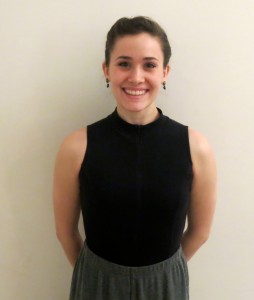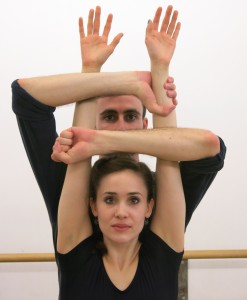Brittany Posas
 Interview with Brittany
Interview with Brittany
Name: Brittany Andrea Posas
Hometown: Raleigh, North Carolina
What in your dance background has shaped you into the dancer that you are today? Growing up with competition dance and dancing for a collegiate Varsity dance team taught me to pick up choreography quickly, retain choreography, and be able to perform on a whim. It also taught me to fight for the things I truly want and to commit whole-heartedly to the task at hand. Dancing with extracurricular teams at UNC-Chapel Hill showed me the community and love that dance provides for people. American Dance Festival and modern dance exposure in college gave me a love for modern dance. When I really began my modern dance training, it felt as though my body had finally gone home. Without my competitive background, I would not have the edge and spirit I have today and without the experiences of the UNC-Chapel Hill dance community, I would not understand the love and compassion that dance gives to so many.
How do you feel when performing? It’s exhilarating, facing an audience. Sometimes when words fail, movement can say so much more, and in a performance setting, you know a crowd of people is sitting quietly and really listening. They have paid to share in what you have to say. It’s the most intimate, vulnerable setting you can exist in, but for a brief moment you can share, inspire, motivate, and affect everyone who is watching.
What is your warm-up ritual? Foam rolling my quads, IT band, gluts, hamstrings, adductors and calves, 1 to 2 minutes of plank and plank variations, hip extensions, some downward dogs to push-up variations, light jogging in place or jumping jacks, 30 seconds of lying on the floor and connecting my core to my rib cage to my pelvis, and some more deep abdominal work.
What’s in your dance bag? Ballet, jazz, and character shoes, Icy/Hot, two ankle braces, a knee brace and an arch support, a lacrosse ball and sometimes an extra shirt or sports bra. Occasionally I throw in extra socks.
 What is the most rewarding aspect of being a dancer? This question, for me, goes back to why I love performing. Dance gives me a means of communication that is universal and goes deeper than language could ever go. Knowing that you can connect with someone past the superficiality of the everyday helps you to never get lost in the trivial. It reminds you there is a larger meaning and connectedness to life. Dance gives me a chance to tap into the rhythm of the universe. Plus I am a kinesthetic learner and relate to the world through physicality, so dance is perfect for me.
What is the most rewarding aspect of being a dancer? This question, for me, goes back to why I love performing. Dance gives me a means of communication that is universal and goes deeper than language could ever go. Knowing that you can connect with someone past the superficiality of the everyday helps you to never get lost in the trivial. It reminds you there is a larger meaning and connectedness to life. Dance gives me a chance to tap into the rhythm of the universe. Plus I am a kinesthetic learner and relate to the world through physicality, so dance is perfect for me.
What is a normal day-in-the-life for you? I wake up at 6:30, get ready and head to my 8:30 ballet class at the Ailey School. Depending on the day, then I have either Horton or Graham technique, Taylor technique or West African. I have three classes a day, and typically finish around 1:00 pm. Then it’s either straight to rehearsal with DGDC, followed by one of my two jobs, or straight to one of my two jobs and then the other. It’s a busy life! Somewhere in there I find time to eat and sleep. Ha!
What keeps you going? I fully believe in the power of cross-training. In addition to the twenty-ish hours a week I’m in class and the days of rehearsal I have with DGDC, I also try to fit in at least two sessions of weight training, and on a good week at least one session of yoga. Your body needs to be challenged with different movement patterns to promote healthy muscle and bone growth as well as prevent injuries sustained through overuse and repetition (a.k.a. getting stuck in only one movement style). There is such thing as over training though! I consider it good to at least get one weight training session in, and always shoot for two, but any more and my body would quit on me.
What led you to the Company? During the audition process, I remember watching Daniel’s repertory video. I was drawn to the athleticism in the movement and how it was true to body and form. It was also risky and daring, which I felt would challenge me to grow as a dancer. This finalized my decision to audition, and I feel fortunate to be working with him now.
Describe the process of working on The Oracle? It’s interesting going on that choreographic journey with him, because a lot of what we are doing now focuses on phrase work and experimentation. We are open to trying anything he envisions, so the key to the process right now is remembering it’s a process; we are all so flexible to the new ideas that are being explored.
What has been most challenging about the process? We have been learning so much material that I think right now the most challenging thing about the choreographic process and putting the piece together is just remembering everything. And remaining flexible when something that feels like set work changes. I have to remind myself on a daily basis “change is the only constant” and just let myself have space to accept and embrace that.
Have you made any new discoveries during the rehearsal process? I’m learning how to let go and give into the movement, and when I can find my technique and utilize to its most efficient capabilities. I have a tendency to hold myself and be in utter control of my body, but Daniel’s movement requires that risk of being loose and open and just letting go. I have to trust my body and take the risks. I am really starting to feel that process take shape and it’s thrilling and new for me.
Why do you think someone should come to see The Oracle at BAM at the end of May? The Oracle is sure to be a riveting and daring show. You can expect to see a lot of boundary-pushing choreography steeped in emotion, exploration and intention. Hope to see you all there!!

